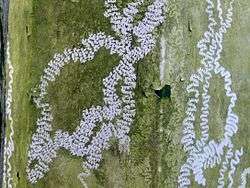Herbivore
A herbivore is an animal anatomically and physiologically adapted to eating plant material, for example foliage or marine algae, for the main component of its diet. As a result of their plant diet, herbivorous animals typically have mouthparts adapted to rasping or grinding. Horses and other herbivores have wide flat teeth that are adapted to grinding grass, tree bark, and other tough plant material.
_grazing_-_20050809.jpg)
.jpg)
A large percentage of herbivores have mutualistic gut flora that help them digest plant matter, which is more difficult to digest than animal prey.[1] This flora is made up of cellulose-digesting protozoans or bacteria.[2]
Etymology
Herbivore is the anglicized form of a modern Latin coinage, herbivora, cited in Charles Lyell's 1830 Principles of Geology.[3] Richard Owen employed the anglicized term in an 1854 work on fossil teeth and skeletons.[3] Herbivora is derived from the Latin herba meaning a small plant or herb,[4] and vora, from vorare, to eat or devour.[5]
Definition and related terms
Herbivory is a form of consumption in which an organism principally eats autotrophs[6] such as plants, algae and photosynthesizing bacteria. More generally, organisms that feed on autotrophs in general are known as primary consumers. Herbivory is usually limited to animals that eat plants. Fungi, bacteria, and protists that feed on living plants are usually termed plant pathogens (plant diseases), while fungi and microbes that feed on dead plants are described as saprotrophs. Flowering plants that obtain nutrition from other living plants are usually termed parasitic plants. There is, however, no single exclusive and definitive ecological classification of consumption patterns; each textbook has its own variations on the theme.[7][8][9]
Evolution of herbivory
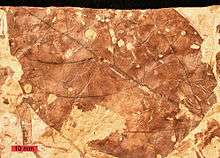
The understanding of herbivory in geological time comes from three sources: fossilized plants, which may preserve evidence of defence (such as spines), or herbivory-related damage; the observation of plant debris in fossilised animal faeces; and the construction of herbivore mouthparts.[10]
Although herbivory was long thought to be a Mesozoic phenomenon, fossils have shown that within less than 20 million years after the first land plants evolved, plants were being consumed by arthropods.[11] Insects fed on the spores of early Devonian plants, and the Rhynie chert also provides evidence that organisms fed on plants using a "pierce and suck" technique.[10]
During the next 75 million years, plants evolved a range of more complex organs, such as roots and seeds. There is no evidence of any organism being fed upon until the middle-late Mississippian, 330.9 million years ago. There was a gap of 50 to 100 million years between the time each organ evolved and the time organisms evolved to feed upon them; this may be due to the low levels of oxygen during this period, which may have suppressed evolution.[11] Further than their arthropod status, the identity of these early herbivores is uncertain.[11] Hole feeding and skeletonization are recorded in the early Permian, with surface fluid feeding evolving by the end of that period.[10]
Herbivory among four-limbed terrestrial vertebrates, the tetrapods developed in the Late Carboniferous (307 – 299 million years ago).[12] Early tetrapods were large amphibious piscivores. While amphibians continued to feed on fish and insects, some reptiles began exploring two new food types, tetrapods (carnivory) and plants (herbivory). The entire dinosaur order ornithischia was composed with herbivores dinosaurs.[12] Carnivory was a natural transition from insectivory for medium and large tetrapods, requiring minimal adaptation. In contrast, a complex set of adaptations was necessary for feeding on highly fibrous plant materials.[12]
Arthropods evolved herbivory in four phases, changing their approach to it in response to changing plant communities.[13]
Tetrapod herbivores made their first appearance in the fossil record of their jaws near the Permio-Carboniferous boundary, approximately 300 million years ago. The earliest evidence of their herbivory has been attributed to dental occlusion, the process in which teeth from the upper jaw come in contact with teeth in the lower jaw is present. The evolution of dental occlusion led to a drastic increase in plant food processing and provides evidence about feeding strategies based on tooth wear patterns. Examination of phylogenetic frameworks of tooth and jaw morphologes has revealed that dental occlusion developed independently in several lineages tetrapod herbivores. This suggests that evolution and spread occurred simultaneously within various lineages.[14]
Food chain
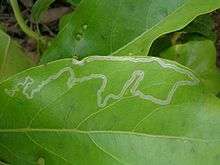
Herbivores form an important link in the food chain because they consume plants to digest the carbohydrates photosynthetically produced by a plant. Carnivores in turn consume herbivores for the same reason, while omnivores can obtain their nutrients from either plants or animals. Due to a herbivore's ability to survive solely on tough and fibrous plant matter, they are termed the primary consumers in the food cycle (chain). Herbivory, carnivory, and omnivory can be regarded as special cases of consumer–resource interactions.[15]
Feeding strategies
Two herbivore feeding strategies are grazing (e.g. cows) and browsing (herbivory) (e.g. moose). For a terrestrial mammal to be called a grazer, at least 90% of the forage has to be grass, and for a browser at least 90% tree leaves and/or twigs. An intermediate feeding strategy is called "mixed-feeding".[16] In their daily need to take up energy from forage, herbivores of different body mass may be selective in choosing their food.[17] "Selective" means that herbivores may choose their forage source depending on, e.g., season or food availability, but also that they may choose high quality (and consequently highly nutritious) forage before lower quality. The latter especially is determined by the body mass of the herbivore, with small herbivores selecting for high-quality forage, and with increasing body mass animals are less selective.[17] Several theories attempt to explain and quantify the relationship between animals and their food, such as Kleiber's law, Holling's disk equation and the marginal value theorem (see below).
Kleiber's law describes the relationship between an animal's size and its feeding strategy, saying that larger animals need to eat less food per unit weight than smaller animals.[18] Kleiber's law states that the metabolic rate (q0) of an animal is the mass of the animal (M) raised to the 3/4 power: q0=M3/4 Therefore, the mass of the animal increases at a faster rate than the metabolic rate.[19]
Herbivores employ numerous types of feeding strategies. Many herbivores do not fall into one specific feeding strategy, but employ several strategies and eat a variety of plant parts.
| Feeding Strategy | Diet | Example |
|---|---|---|
| Algivores | Algae | krill, crabs, sea snail, sea urchin, parrotfish, surgeonfish, flamingo |
| Frugivores | Fruit | Ruffed lemurs |
| Folivores | Leaves | Koalas |
| Nectarivores | Nectar | Honey possum |
| Granivores | Seeds | Hawaiian honeycreepers |
| Palynivores | Pollen | Bees |
| Mucivores | Plant fluids, i.e. sap | Aphids |
| Xylophages | Wood | Termites |
Optimal Foraging Theory is a model for predicting animal behavior while looking for food or other resources, such as shelter or water. This model assesses both individual movement, such as animal behavior while looking for food, and distribution within a habitat, such as dynamics at the population and community level. For example, the model would be used to look at the browsing behavior of a deer while looking for food, as well as that deer's specific location and movement within the forested habitat and its interaction with other deer while in that habitat.[20]
This model has been criticized as circular and untestable. Critics have pointed out that its proponents use examples that fit the theory, but do not use the model when it does not fit the reality.[21][22] Other critics point out that animals do not have the ability to assess and maximize their potential gains, therefore the optimal foraging theory is irrelevant and derived to explain trends that do not exist in nature.[23][24]
Holling's disk equation models the efficiency at which predators consume prey. The model predicts that as the number of prey increases, the amount of time predators spend handling prey also increases, and therefore the efficiency of the predator decreases.[25] In 1959, S. Holling proposed an equation to model the rate of return for an optimal diet: Rate (R )=Energy gained in foraging (Ef)/(time searching (Ts) + time handling (Th))
Where s=cost of search per unit time f=rate of encounter with items, h=handling time, e=energy gained per encounter
In effect, this would indicate that a herbivore in a dense forest would spend more time handling (eating) the vegetation because there was so much vegetation around than a herbivore in a sparse forest, who could easily browse through the forest vegetation. According to the Holling's disk equation, a herbivore in the sparse forest would be more efficient at eating than the herbivore in the dense forest.
The marginal value theorem describes the balance between eating all the food in a patch for immediate energy, or moving to a new patch and leaving the plants in the first patch to regenerate for future use. The theory predicts that absent complicating factors, an animal should leave a resource patch when the rate of payoff (amount of food) falls below the average rate of payoff for the entire area.[26] According to this theory, locus should move to a new patch of food when the patch they are currently feeding on requires more energy to obtain food than an average patch. Within this theory, two subsequent parameters emerge, the Giving Up Density (GUD) and the Giving Up Time (GUT). The Giving Up Density (GUD) quantifies the amount of food that remains in a patch when a forager moves to a new patch.[27] The Giving Up Time (GUT) is used when an animal continuously assesses the patch quality.[28]
Attacks and counter-attacks
Herbivore offense
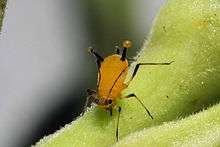
The myriad defenses displayed by plants means that their herbivores need a variety of skills to overcome these defenses and obtain food. These allow herbivores to increase their feeding and use of a host plant. Herbivores have three primary strategies for dealing with plant defenses: choice, herbivore modification, and plant modification.
Feeding choice involves which plants a herbivore chooses to consume. It has been suggested that many herbivores feed on a variety of plants to balance their nutrient uptake and to avoid consuming too much of any one type of defensive chemical. This involves a tradeoff however, between foraging on many plant species to avoid toxins or specializing on one type of plant that can be detoxified.[29]
Herbivore modification is when various adaptations to body or digestive systems of the herbivore allow them to overcome plant defenses. This might include detoxifying secondary metabolites,[30] sequestering toxins unaltered,[31] or avoiding toxins, such as through the production of large amounts of saliva to reduce effectiveness of defenses. Herbivores may also utilize symbionts to evade plant defences. For example, some aphids use bacteria in their gut to provide essential amino acids lacking in their sap diet.[32]
Plant modification occurs when herbivores manipulate their plant prey to increase feeding. For example, some caterpillars roll leaves to reduce the effectiveness of plant defenses activated by sunlight.[33]
Plant defense
A plant defense is a trait that increases plant fitness when faced with herbivory. This is measured relative to another plant that lacks the defensive trait. Plant defenses increase survival and/or reproduction (fitness) of plants under pressure of predation from herbivores.
Defense can be divided into two main categories, tolerance and resistance. Tolerance is the ability of a plant to withstand damage without a reduction in fitness.[34] This can occur by diverting herbivory to non-essential plant parts, resource allocation, compensatory growth, or by rapid regrowth and recovery from herbivory.[35] Resistance refers to the ability of a plant to reduce the amount of damage it receives from herbivores.[34] This can occur via avoidance in space or time,[36] physical defenses, or chemical defenses. Defenses can either be constitutive, always present in the plant, or induced, produced or translocated by the plant following damage or stress.[37]
Physical, or mechanical, defenses are barriers or structures designed to deter herbivores or reduce intake rates, lowering overall herbivory. Thorns such as those found on roses or acacia trees are one example, as are the spines on a cactus. Smaller hairs known as trichomes may cover leaves or stems and are especially effective against invertebrate herbivores.[38] In addition, some plants have waxes or resins that alter their texture, making them difficult to eat. Also the incorporation of silica into cell walls is analogous to that of the role of lignin in that it is a compression-resistant structural component of cell walls; so that plants with their cell walls impregnated with silica are thereby afforded a measure of protection against herbivory.[39]
Chemical defenses are secondary metabolites produced by the plant that deter herbivory. There are a wide variety of these in nature and a single plant can have hundreds of different chemical defenses. Chemical defenses can be divided into two main groups, carbon-based defenses and nitrogen-based defenses.
- Carbon-based defenses include terpenes and phenolics. Terpenes are derived from 5-carbon isoprene units and comprise essential oils, carotenoids, resins, and latex. They can have several functions that disrupt herbivores such as inhibiting adenosine triphosphate (ATP) formation, molting hormones, or the nervous system.[40] Phenolics combine an aromatic carbon ring with a hydroxyl group. There are several different phenolics such as lignins, which are found in cell walls and are very indigestible except for specialized microorganisms; tannins, which have a bitter taste and bind to proteins making them indigestible; and furanocumerins, which produce free radicals disrupting DNA, protein, and lipids, and can cause skin irritation.
- Nitrogen-based defenses are synthesized from amino acids and primarily come in the form of alkaloids and cyanogens. Alkaloids include commonly recognized substances such as caffeine, nicotine, and morphine. These compounds are often bitter and can inhibit DNA or RNA synthesis or block nervous system signal transmission. Cyanogens get their name from the cyanide stored within their tissues. This is released when the plant is damaged and inhibits cellular respiration and electron transport.
Plants have also changed features that enhance the probability of attracting natural enemies to herbivores. Some emit semiochemicals, odors that attract natural enemies, while others provide food and housing to maintain the natural enemies' presence, e.g. ants that reduce herbivory.[41] A given plant species often has many types of defensive mechanisms, mechanical or chemical, constitutive or induced, which allow it to escape from herbivores.
Herbivore–plant interactions per predator–prey theory
According to the theory of predator–prey interactions, the relationship between herbivores and plants is cyclic.[42] When prey (plants) are numerous their predators (herbivores) increase in numbers, reducing the prey population, which in turn causes predator number to decline.[43] The prey population eventually recovers, starting a new cycle. This suggests that the population of the herbivore fluctuates around the carrying capacity of the food source, in this case, the plant.
Several factors play into these fluctuating populations and help stabilize predator-prey dynamics. For example, spatial heterogeneity is maintained, which means there will always be pockets of plants not found by herbivores. This stabilizing dynamic plays an especially important role for specialist herbivores that feed on one species of plant and prevents these specialists from wiping out their food source.[44] Prey defenses also help stabilize predator-prey dynamics, and for more information on these relationships see the section on Plant Defenses. Eating a second prey type helps herbivores' populations stabilize.[45] Alternating between two or more plant types provides population stability for the herbivore, while the populations of the plants oscillate.[46] This plays an important role for generalist herbivores that eat a variety of plants. Keystone herbivores keep vegetation populations in check and allow for a greater diversity of both herbivores and plants.[45] When an invasive herbivore or plant enters the system, the balance is thrown off and the diversity can collapse to a monotaxon system.[45]
The back and forth relationship of plant defense and herbivore offense drives coevolution between plants and herbivores, resulting in a "coevolutionary arms race".[30][47] The escape and radiation mechanisms for coevolution, presents the idea that adaptations in herbivores and their host plants, has been the driving force behind speciation.[48][49]
While much of the interaction of herbivory and plant defense is negative, with one individual reducing the fitness of the other, some is beneficial. This beneficial herbivory takes the form of mutualisms in which both partners benefit in some way from the interaction. Seed dispersal by herbivores and pollination are two forms of mutualistic herbivory in which the herbivore receives a food resource and the plant is aided in reproduction.[50]
Impacts
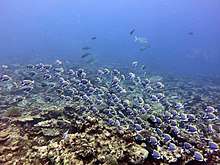
Herbivorous fish and marine animals are indispensable parts of the coral reef ecosystem. Since algae and seaweeds grow much faster than corals, they can occupy spaces where corals could have settled. They can outgrow and thus outcompete corals on bare surfaces. In the absence of plant-eating fish, seaweeds deprive corals of sunlight.[51]
Herbivory can have impacts on both economics and ecology. For example, environmental degradation from white-tailed deer (Odocoileus virginianus) in the US alone has the potential to both change vegetative communities[52] through over-browsing and cost forest restoration projects upwards of $750 million annually. Agricultural crop damage by the same species totals approximately $100 million every year. Insect crop damages also contribute largely to annual crop losses in the U.S.[53] Herbivores affect economics through the revenue generated by hunting and ecotourism. For example, the hunting of herbivorous game species such as white-tailed deer, cottontail rabbits, antelope, and elk in the U.S. contributes greatly to the billion-dollar annually, hunting industry. Ecotourism is a major source of revenue, particularly in Africa, where many large mammalian herbivores such as elephants, zebras, and giraffes help to bring in the equivalent of millions of US dollars to various nations annually.
See also
| Wikimedia Commons has media related to Herbivores. |
References
- Moran, N.A. (2006). "Symbiosis". Current Biology. 16 (20): 866–871. doi:10.1016/j.cub.2006.09.019. PMID 17055966.
- "symbiosis." The Columbia Encyclopedia. New York: Columbia University Press, 2008. Credo Reference. Web. 17 September 2012.
- J.A. Simpson and E.S.C. Weiner, Eds. (2000) "The Oxford English Dictionary (volume VII) page 155.
- P.G.W. Glare, Ed. (1990) "The Oxford Latin Dictionary" page 791
- P.G.W. Glare, Ed. (1990) "The Oxford Latin Dictionary" page 2103.
- Abraham, Martin A. A. Sustainability Science and Engineering, Volume 1. page 123. Publisher: Elsevier 2006. ISBN 978-0444517128
- Thomas, Peter & Packham, John. Ecology of Woodlands and Forests: Description, Dynamics and Diversity. Publisher: Cambridge University Press 2007. ISBN 978-0521834520
- Sterner, Robert W.; Elser, James J.; and Vitousek, Peter. Ecological Stoichiometry: The Biology of Elements from Molecules to the Biosphere. Publisher: Princeton University Press 2002. ISBN 978-0691074917
- Likens Gene E. Lake Ecosystem Ecology: A Global Perspective. Publisher: Academic Press 2010. ISBN 978-0123820020
- Labandeira, C.C. (1998). "Early History of Arthropod And Vascular Plant Associations 1". Annual Review of Earth and Planetary Sciences. 26 (1): 329–377. Bibcode:1998AREPS..26..329L. doi:10.1146/annurev.earth.26.1.329.
- Labandeira, C. (June 2007). "The origin of herbivory on land: Initial patterns of plant tissue consumption by arthropods". Insect Science. 14 (4): 259–275. doi:10.1111/j.1744-7917.2007.00141.x-i1.
- Sahney, S., Benton, M.J. & Falcon-Lang, H.J. (2010). "Rainforest collapse triggered Pennsylvanian tetrapod diversification in Euramerica". Geology. 38 (12): 1079–1082. Bibcode:2010Geo....38.1079S. doi:10.1130/G31182.1.CS1 maint: multiple names: authors list (link)
- Labandeira, C.C. (2005). "The four phases of plant-arthropod associations in deep time" (PDF). Geologica Acta. 4 (4): 409–438. Archived from the original (Free full text) on 26 June 2008. Retrieved 15 May 2008.
- Reisz, Robert R. (2006), "Origin of dental occlusion in tetrapods: Signal for terrestrial vertebrate evolution?", Journal of Experimental Zoology Part B: Molecular and Developmental Evolution, 306B (3): 261–277, doi:10.1002/jez.b.21115, PMID 16683226
- Getz, W (February 2011). "Biomass transformation webs provide a unified approach to consumer-resource modelling". Ecology Letters. 14 (2): 113–124. doi:10.1111/j.1461-0248.2010.01566.x. PMC 3032891. PMID 21199247.
- Janis, C. (1990). "Chapter 13: Correlation of cranial and dental variables with body size in ungulates and macropodoids". In Damuth, J.; MacFadden, B.J. (eds.). Body Size in Mammalian Paleobiology: Estimation and Biological Implications. Cambridge University Press. pp. 255–299.
- Belovsky, G.E. (November 1997). "Optimal foraging and community structure: The allometry of herbivore food selection and competition". Evolutionary Ecology. 11 (6): 641–672. doi:10.1023/A:1018430201230.
- Nugent, G; Challies, CN (1988). "Diet and food preferences of white-tailed deer in north-eastern Stewart Island". New Zealand Journal of Ecology. 11: 61–73.
- Nugent and Challies, 1988
- Kie, John G. (1999). "Optimal Foraging & Risk of Predation: Effects on Behavior & Social Structure in Ungulates". Journal of Mammalogy. 80 (4): 1114–1129. doi:10.2307/1383163. JSTOR 1383163.
- Pierce, G. J.; Ollason, J. G. (May 1987). "Eight reasons why optimal foraging theory is a complete waste of time". Oikos. 49 (1): 111–118. doi:10.2307/3565560. JSTOR 3565560.
- Stearns, S. C.; Schmid-Hempel, P. (May 1987). "Evolutionary insights should not be wasted". Oikos. 49 (1): 118–125. doi:10.2307/3565561. JSTOR 3565561.
- Lewis, A. C. (16 May 1986). "Memory constraints and flower choice in Pieris rapae". Science. 232 (4752): 863–865. Bibcode:1986Sci...232..863L. doi:10.1126/science.232.4752.863. PMID 17755969.
- Janetos, A. C.; Cole, B. J. (October 1981). "Imperfectly optimal animals". Behav. Ecol. Sociobiol. 9 (3): 203–209. doi:10.1007/bf00302939.
- Stephens, D. W., and J. R. Krebs. 1986. Foraging theory. Princeton University Press
- Charnov, E. L. 1976. Optimal foraging, the marginal value theorem. Theor. Pop. Biol.-9:129–136.
- Brown, J. S., B P. Kotler, and W A. Mitchell. 1997. Competition between birds and mammals: a comparison of giving-up densities between crested larks and gerbils. Evol. Ecol. 11:757–771.
- Breed, M. D. R. M. Bowden, M. F. Garry, and A. L. Weicker. 1996. Giving-up time variation in response to differences in nectar volume and concentration in the giant tropical ant, Paraponera clavata. J. Ins. behav. 9:659–672
- Dearing, M.D.; Mangione, A.M.; Karasov, W.H. (May 2000). "Diet breadth of mammalian herbivores: nutrient versus detoxification constraints". Oecologia. 123 (3): 397–405. Bibcode:2000Oecol.123..397D. doi:10.1007/s004420051027. PMID 28308595.
- Karban, R.; Agrawal, A.A. (November 2002). "Herbivore Offense". Annual Review of Ecology and Systematics. 33: 641–664. doi:10.1146/annurev.ecolsys.33.010802.150443.
- Nishida, R. (January 2002). "Sequestration of Defensive Substances from Plants by Lepidoptera". Annual Review of Entomology. 47: 57–92. doi:10.1146/annurev.ento.47.091201.145121. PMID 11729069.
- Douglas, A.E. (January 1998). "Nutritional Interactions in Insect–Microbial Symbioses: Aphids and Their Symbiotic Bacteria Buchnera". Annual Review of Entomology. 43: 17–37. doi:10.1146/annurev.ento.43.1.17. PMID 15012383.
- Sagers, C.L. (1992). "Manipulation of host plant quality: herbivores keep leaves in the dark". Functional Ecology. 6 (6): 741–743. doi:10.2307/2389971. JSTOR 2389971.
- Call, Anson; St Clair, Samuel B (1 October 2018). Ryan, Michael (ed.). "Timing and mode of simulated ungulate herbivory alter aspen defense strategies". Tree Physiology. 38 (10): 1476–1485. doi:10.1093/treephys/tpy071. ISSN 1758-4469. PMID 29982736.
- Hawkes, Christine V.; Sullivan, Jon J. (2001). "THE IMPACT OF HERBIVORY ON PLANTS IN DIFFERENT RESOURCE CONDITIONS: A META-ANALYSIS" Check
|url=value (help). 82: 2045–2058 – via Wiley. Cite journal requires|journal=(help) - Milchunas, D.G.; Noy-Meir, I. (October 2002). "Grazing refuges, external avoidance of herbivory and plant diversity". Oikos. 99 (1): 113–130. doi:10.1034/j.1600-0706.2002.990112.x.
- Edwards, P.J.; Wratten, S.D. (March 1985). "Induced plant defences against insect grazing: fact or artefact?". Oikos. 44 (1): 70–74. doi:10.2307/3544045. JSTOR 3544045.
- Pillemer, E.A.; Tingey, W.M. (6 August 1976). "Hooked Trichomes: A Physical Plant Barrier to a Major Agricultural Pest". Science. 193 (4252): 482–484. Bibcode:1976Sci...193..482P. doi:10.1126/science.193.4252.482. PMID 17841820.
- PNAS Vol 91 Jan 1994 a Review by Emanuel Epstein
- Langenheim, J.H. (June 1994). "Higher plant terpenoids: a phytocentric overview of their ecological roles". Journal of Chemical Ecology. 20 (6): 1223–1280. doi:10.1007/BF02059809. PMID 24242340.
- Heil, M.; Koch, T.; Hilpert, A.; Fiala, B.; Boland, W.; Linsenmair, K. Eduard (30 January 2001). "Extrafloral nectar production of the ant-associated plant, Macaranga tanarius, is an induced, indirect, defensive response elicited by jasmonic acid". Proceedings of the National Academy of Sciences. 98 (3): 1083–1088. Bibcode:2001PNAS...98.1083H. doi:10.1073/pnas.031563398. PMC 14712. PMID 11158598.
- Gotelli, NJ. A Primer of Ecology. Sinauer Associates Inc., Mass. 1995
- Gotelli 1995
- Smith, RL and Smith, TM. Ecology and Field Biology: Sixth Edition.Benjamin Cummings, New York. 2001
- Smith and Smith, 2001
- Gotelli, 1995
- Mead, R.J.; Oliver, A.J.; King, D.R.; Hubach, P.H. (March 1985). "The Co-Evolutionary Role of Fluoroacetate in Plant–Animal Interactions in Australia". Oikos. 44 (1): 55–60. doi:10.2307/3544043. JSTOR 3544043.
- Ehrlich, P. R.; Raven, P. H. (December 1964). "Butterflies and plants: a study of coevolution". Evolution. 18 (4): 586–608. doi:10.2307/2406212. JSTOR 2406212.
- Thompson, J. 1999. What we know and do not know about coevolution: insect herbivores and plants as a test case. Pages 7–30 in H. Olff, V. K. Brown, R. H. Drent, and British Ecological Society Symposium 1997 (Corporate Author), editors. Herbivores: between plants and predators. Blackwell Science, London, UK.
- Herrera, C.M. (March 1985). "Determinants of Plant-Animal Coevolution: The Case of Mutualistic Dispersal of Seeds by Vertebrates". Oikos. 44 (1): 132–141. doi:10.2307/3544054. JSTOR 3544054.
- "Plant-eating fish, Information sheets for fishing communities No 29". SPC (www.spc.int) in collaboration with the LMMA Network (www.lmmanetwork.org). n.d. Missing or empty
|url=(help) - Seager, S Trent; Eisenberg, Cristina; St. Clair, Samuel B. (July 2013). "Patterns and consequences of ungulate herbivory on aspen in western North America". Forest Ecology and Management. 299: 81–90. doi:10.1016/j.foreco.2013.02.017.
- An Integrated Approach To Deer Damage Control Publication No. 809 West Virginia Division of Natural Resources Cooperative Extension Service, Wildlife Resources Section West Virginia University, Law Enforcement Section Center for Extension and Continuing Education, March 1999
Further reading
- Bob Strauss, 2008, Herbivorous Dinosaurs, The New York Times
- Danell, K., R. Bergström, P. Duncan, J. Pastor (Editors)(2006) Large herbivore ecology, ecosystem dynamics and conservation Cambridge, UK : Cambridge University Press. 506 p. ISBN 0-521-83005-2
- Crawley, M. J. (1983) Herbivory : the dynamics of animal-plant interactions Oxford : Blackwell Scientific. 437 p. ISBN 0-632-00808-3
- Olff, H., V.K. Brown, R.H. Drent (editors) (1999) Herbivores : between plants and predators Oxford ; Malden, Ma. : Blackwell Science. 639 p. ISBN 0-632-05155-8
